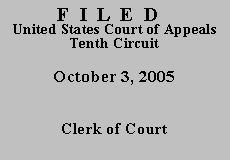

| UNITED STATES OF AMERICA,
Plaintiff-Appellee, |
|
| v. | |
| ALLAN WHITEHEAD,
Defendant-Appellant. |
Julie George, Salt Lake City, Utah, for the defendant-appellant.
Dave Backman, Assistant United States Attorney and Paul M. Warner, United States Attorney, District of Utah, Salt Lake City, Utah, for the plaintiff-appellee.
On June 19, 2003, a six-count indictment was returned against Whitehead charging him with five firearms-related offenses and one drug-related offense. On July 26, 2004, Whitehead pled guilty to Count 5 of the indictment, which alleged that "[o]n or about April 18, 2003," Whitehead, "having been convicted of a crime punishable by imprisonment for more than one (1) year, did knowingly possess, in and affecting interstate commerce, a firearm, to wit: a 9 mm handgun; in violation of 18 U.S.C. § 922(g)(1)." ROA, Vol. I, Doc. 1, at 3. A presentence investigation report (PSR) was subsequently prepared that proposed the imposition of a base offense level of 20 pursuant to U.S.S.G. § 2K2.1(a)(4)(B) because, in pertinent part, Whitehead "possessed a prohibited firearm described in 18 U.S.C. § 921(a)(30)." ROA, Vol. III, PSR, Addendum at 1. At the sentencing hearing on October 6, 2004, Whitehead objected to this base offense level, arguing that, because § 921(a)(30) had been repealed, § 2K2.1(a)(4)(B) was inapplicable. The district court rejected Whitehead's argument, adopted the PSR's calculations, and sentenced Whitehead to forty-one months' imprisonment, a term at the bottom of the guideline range.
Whitehead renews his argument on appeal, contending the district court should have imposed a lower base offense level because, at the time of his sentencing, the firearm he was convicted of possessing was not, and indeed could not have been, listed in § 921(a)(30). Because Whitehead's argument involves the legal interpretation of § 2K2.1(a)(4)(B) of the Guidelines, we review the district court's ruling de novo. See United States v. Wilson, 416 F.3d 1164, 1167 (10th Cir. 2005).
Section 2K2.1(a)(4)(B) of the Sentencing Guidelines requires imposition of a base offense level of twenty "if . . . the offense involved a firearm described in . . . 18 U.S.C. § 921(a)(30) . . . and the defendant . . . was a prohibited person at the time [he] committed the instant offense . . . ." It is undisputed that Whitehead was a convicted felon, and thus qualified as a "prohibited person," at the time he committed the offense of conviction. Therefore, his appeal hinges on whether the offense of conviction "involved a firearm described in . . . 18 U.S.C. § 921(a)(30)."
At the time of Whitehead's offense (i.e., April 18, 2003), § 921(a)(30) defined the term "semiautomatic assault weapon." That definition included various specific firearms as well as firearms that bore certain specific characteristics. It is uncontroverted that the firearm Whitehead was convicted of possessing fell within this definition. Notably, however, § 921(a)(30) was repealed after the Violent Crime Control and Law Enforcement Act of 1994, 108 Stat. 1796, expired on September 13, 2004 (approximately three weeks before Whitehead was sentenced).
Whitehead contends that, because § 921(a)(30) had been repealed at the time of his sentencing, § 2K2.1(a)(4)(B) was effectively inapplicable and the district court therefore should have imposed a lower base offense level. We disagree. The language of § 2K2.1(a)(4)(B), in particular its reference to whether "the offense [of conviction] involved a firearm described in . . . § 921(a)(30)," was clearly intended, in our view, to focus on the circumstances in existence at the time the offense of conviction was committed. See generally United States v. Gay, 240 F.3d 1222, 1231 (10th Cir. 2000) (noting that Sentencing Guidelines, like criminal statutes, "are given their fair meaning in accord with the manifest intent of the lawmakers.") (internal quotations omitted). In other words, just as it asks whether the defendant was a prohibited person at the time he committed the offense of conviction, § 2K2.1(a)(4)(B) focuses on whether, at the time the offense of conviction was committed, the firearm involved in the offense fell within the definition of "semiautomatic assault weapon" outlined in § 921(a)(30).
Our interpretation is bolstered by the fact that, in the most recent version of the Guidelines Manual (i.e., the version that became effective on November 1, 2004), the Sentencing Commission made no changes to the wording of § 2K2.1(a)(4)(B). Thus, notwithstanding the repeal of § 921(a)(30), § 2K2.1(a)(4)(B) continues to require the imposition of a base offense level of twenty if the defendant was a prohibited person at the time he committed the offense and the firearm involved in the offense fell within the definition of "semiautomatic assault weapon" outlined in § 921(a)(30). Had the Sentencing Commission intended § 2K2.1(a)(4)(B) to focus on the status of the firearm at issue at the time of sentencing rather than at the time the offense of conviction was committed, then the continued reference to § 921(a)(30) would be superfluous, as would § 2K2.1(a)(4)(B) itself.
For these reasons, we conclude the district court did not err in interpreting § 2K2.1(a)(4)(B) or in applying that provision to Whitehead's case.
The judgment of the district court is AFFIRMED.
*. After examining the briefs and appellate record, this panel has determined unanimously that oral argument would not materially assist the determination of this appeal. See Fed. R. App. P. 34(a)(2); 10th Cir. R. 34.1(G). The case is therefore ordered submitted without oral argument.